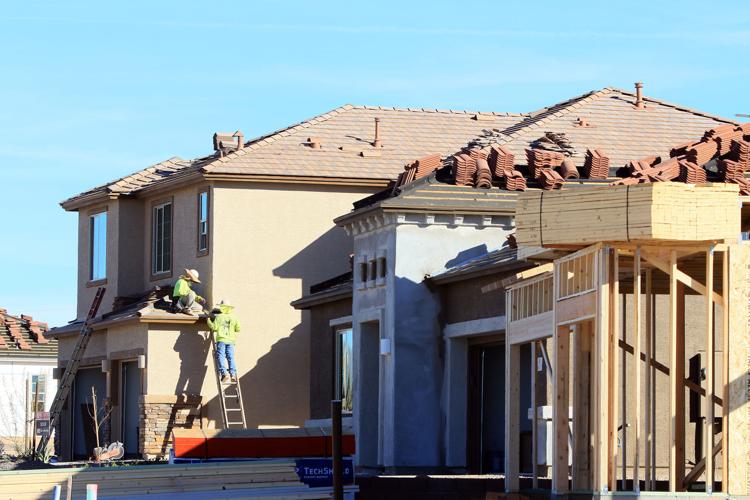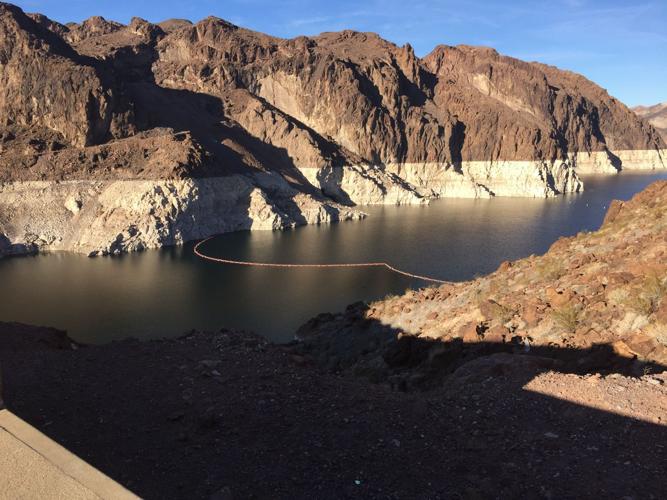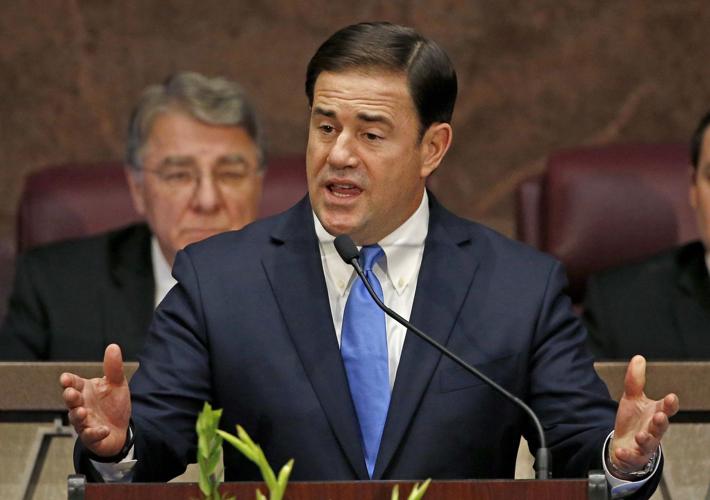Gov. Doug Ducey’s office is pushing a series of controversial proposals to overhaul state water management. One reason is to assure investors that Arizona has enough water for future economic development.
But water agencies are warring over how to make sure there’s enough water for long-term growth, and whether that means saying “no” to some short-term uses.
At issue is what one official calls the Colorado River’s “last supply.” That’s river water that no user with contracts to buy it — meaning cities, tribes, tribes and private water companies — wants in a given year.
Arizona’s water users and agencies are at odds over whether to leave that leftover water in Lake Mead or continue to allow some of it to supply suburban subdivisions, among other uses.
That issue is one of more than a dozen topics now being discussed — in private — by committees and work groups appointed by the governor, in order to “get the state’s act together” on water.
The proposals have split officials of the Central Arizona Project and the Arizona Department of Water Resources and their supporters into competing camps.
In an interview, Ducey’s chief of staff Kirk Adams made it clear that growth is a key factor driving these measures.
With the state’s economy, battered by the 2008 financial crisis and real estate bust, now rebounding, “the governor feels we need to be prepared for the growth,” Adams said.
When Adams meets with CEOs and other corporate decisionmakers considering investing in Arizona, water is consistently mentioned though it’s not at the top of their priority list, he said.
“We’re making sure that we have everything in order, that we don’t have anything impeding our ability to create new jobs,” Adams said.
Adams likened the current time to the era of Arizona’s 1980 Groundwater Management Act, a nationally pioneering law that toughened state controls over excessive groundwater pumping. After that law passed, the state entered into a very big growth period, he said.
“Thirty-five years is a long time for any policy. It’s time to see if there are any gaps or things to be improved on,” he said.
Kathryn Sorensen, the city of Phoenix’s water director, also looked back several decades to explain her view on this dispute.
“For 30 years, this state focused on bringing as much water into the CAP and off the river as possible, to keep it away from California. Now that Lake Mead is tanking, we are looking at a total change in attitudes,” said Sorensen.
“That’s at the heart of this issue — how much water do we leave on the lake? How much do you bring into central Arizona? And who gets to decide this on behalf of the whole state?”
Underlying growth tensions
At stake is a few hundred thousand acre-feet of water, enough to raise Lake Mead by a few feet if it were all put there. So far, the governor's committees haven't come up with a formal proposal for how to deal with this water, and a CAP task force is now trying to sort the issue out separately.
The power struggle over this water has kept the CAP and the Arizona Department of Water Resources from reaching agreement on a broader Drought Contingency Plan-Plus that would cut back the state’s water use to protect Mead’s water levels.
This issue also taps into underlying tensions among suburban developers, homebuilders, ranchers, cities and environmentalists. That’s because a healthy chunk of the leftover river water today goes to the highly controversial Central Arizona Groundwater Replenishment District, which like CAP is operated by the agencies’ parent Central Arizona Water Conservation District.
The river water that goes to the replenishment district compensates for groundwater pumped out for thousands of subdivisions statewide, including dozens in Pima County. Such water is recharged into aquifers. Getting that water ensures that growth in places like Green Valley south of Tucson and Surprise west of Phoenix can continue as planned.
This water is available because Tucson, Phoenix and Indian tribes that have legal contracts for CAP water don’t always need every drop that they had previously planned to buy for a given year. So the CAP lets other users such as the replenishment district, that don’t have such contracts, buy it.
More such leftover water is available because CAP also has the right to take and sell unused river water belonging to irrigation districts, farmers and tribes along the Colorado River.
The replenishment district wants this water because, by state law, the subdivisions within its boundaries can’t develop without a 100-year assured supply of renewable water.
Homebuilders and homeowners of about 1,200 Arizona subdivisions, including 66 in Pima and southern Pinal counties, pay fees to the district to be members.
After the needs of the CAP contract holders are met, the leftover river water goes to:
- The Arizona Water Banking Authority, which stores it in large dirt recharge basins in the Tucson and Phoenix areas for future use in case of a cutoff of river supplies.
- A large pool set aside for Pinal County farmers.
- Lake Pleasant on the Aqua Fria River northwest of Phoenix, also for use in future years.
- The federal government, to help meet its legal obligations from its Indian water rights settlements.
Officials of city water utilities, including Tucson Water and the Phoenix Water Department, told the water conservation district’s governing board in January that they wanted much of this leftover water — although not what’s sold to farmers — to stay in Lake Mead for at least the next three years.
This guarantee will help them persuade their city councils to leave some of their own water in Mead that they would otherwise want to use, the water utility officials say.
They note that their cities are already going to be on the hook for paying higher rates for CAP water once agreements to reduce water use for Mead’s sake kick in; less water raises the tab for each gallon.
At the same time, those officials object to having leftover water delivered to the groundwater district or the water bank, which don’t have contracts for it.
Underneath this debate, many cities and environmentalists have distrusted the replenishment district because they believe it promotes unsustainable growth.
City water officials also say the CAP and the replenishment district have a conflict of interest, because the parent water conservation agency is trying to protect Lake Mead, yet is legally obligated to find water for the replenishment district.
Dennis Rule, the replenishment district’s manager, sees no conflict of interest because he doesn’t believe the CAP governing board would ever agree to deliver excess water to his district if those deliveries lowered Lake Mead enough to create a shortage.
The district doesn’t just benefit suburbs — the city of Tucson itself was only able to prove its 100-year supply back in the 1990s by joining the district because at the time it had shut the CAP off, he said.
CAP officials say they won’t support leaving all unused water in Mead, in part because they don’t know how much is available from year to year. So they don’t want to guarantee anything up front, regardless of future circumstances.
The CAP has a financial stake in this matter. Money the project gets by selling leftover water helps pay off the parent water district’s debt to the federal government for building the $4 billion, 336-mile-long CAP canal.
CAP also holds the legal cards in this issue. It has the right to decide who gets leftover river water, based on past contracts with the U.S. government.
“I’m not confident that it is good public policy to make an automatic, open-ended, unquantified contribution to Lake Mead,” said Tucson-based CAP board member Sharon Megdal. “No other party to these Drought Contingency Plan-Plus negotiations I’m aware of is being asked to do that. You should know what you are contributing and what you are expected to contribute.”
The replenishment district also has influential supporters. The Home Builders Association of Central Arizona recently joined with the Arizona Cattleman’s Association to put a full-page ad into the weekly Arizona Capitol Times supporting the district.
For ranchers, that district’s use of renewable water to boost suburban land development keeps private land values stable. If there’s no ability to get enough water to develop former ranches and farms, their value plummets, said Bas Aja, the cattle growers’ government relations director. “Our ability to borrow money on the value of those lands on my ranch or farm or feedlot goes down dramatically.”
For the homebuilders, “the district fulfills what we believe is a critical component of the state groundwater act — to put water back into the ground,” said Spencer Kamps, its vice president of legislative affairs. “That’s a critical, critical supply. We need that supply.”
As the river’s supplies grow more pinched over the coming years, Kamps knows that the amount available for replenishment will decline. But he wants “a managed decline,” spread out over time.
A quick cutoff wouldn’t stop development because the groundwater replenishment district could buy Colorado River water from other sources. But that water would cost far more than the CAP supply, raising costs for both homebuilders and homebuyers, said Rule, who manages the replenishment district. He estimated the total extra tab at $8.6 million over two years.
“We know we are going to lose that supply. We just struggle with the kind of decision that automatically causes us to lose that,” Kamps told a board meeting of the CAP’s parent last summer.
But for a Sierra Club leader who isn’t siding with either party in the CAP-state water agency dispute, the struggle over unused river water represents what’s wrong with the state’s broader water management.
The Sierra Club has never been a fan of the replenishment district because it promotes “massive sprawl on undisturbed desert,” said Sandy Bahr, director of the group’s Grand Canyon chapter.
But that doesn’t mean the state water agency’s proposals are any better, Bahr said.
“It’s a power struggle between two entities, neither of whom is looking at what is beneficial from an environmental protection standpoint,” she said. “Development is the motivating factor here on both sides. It always is.”








